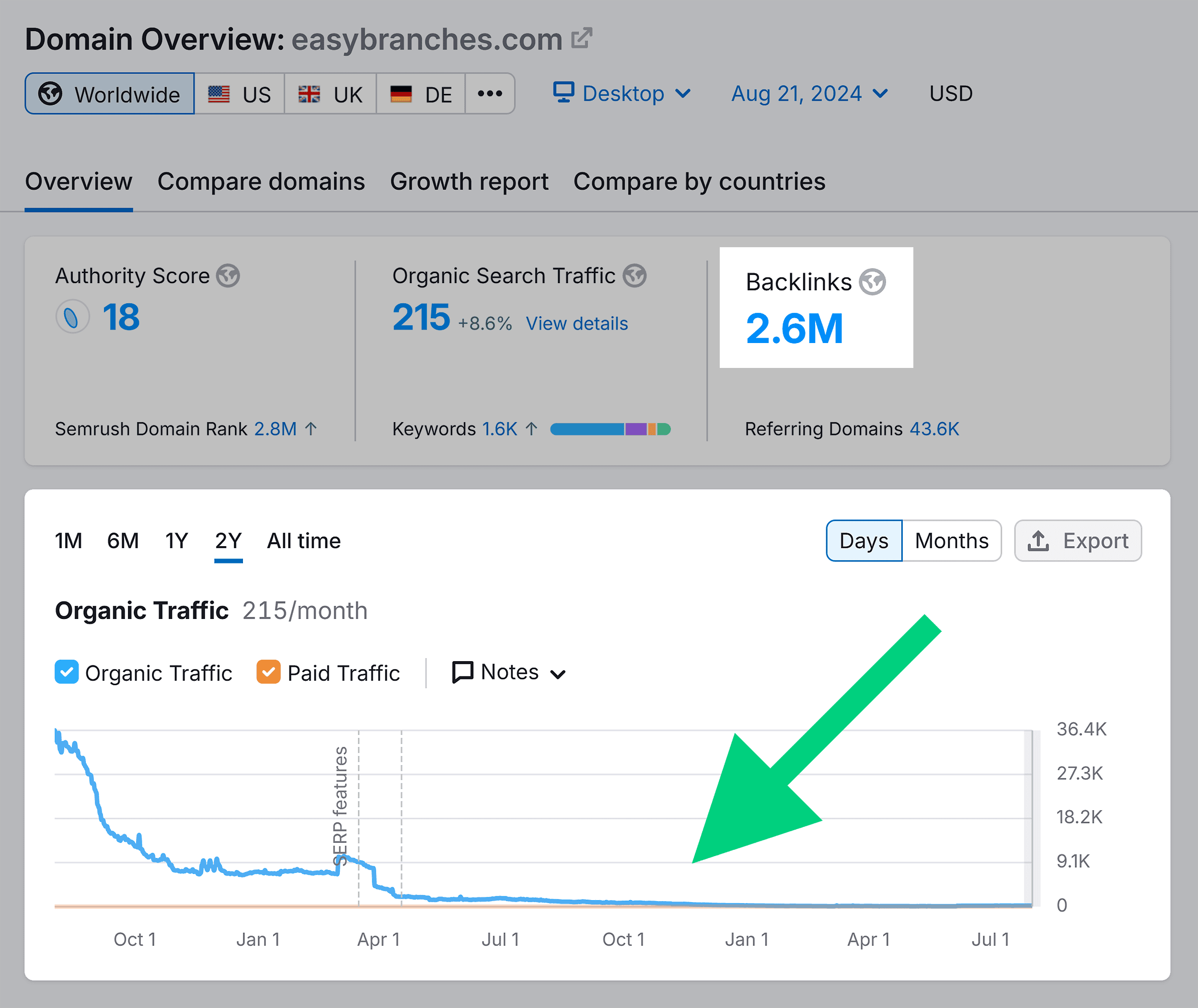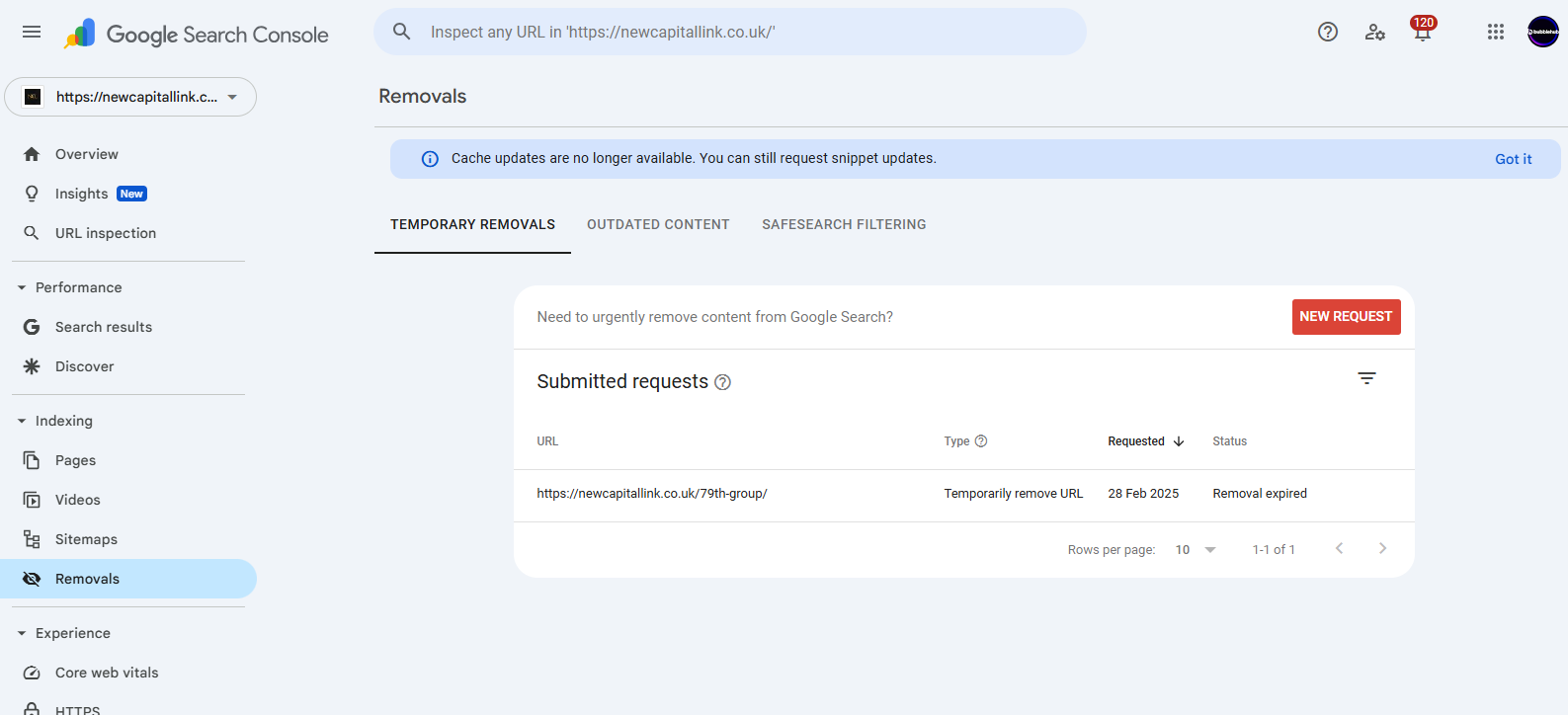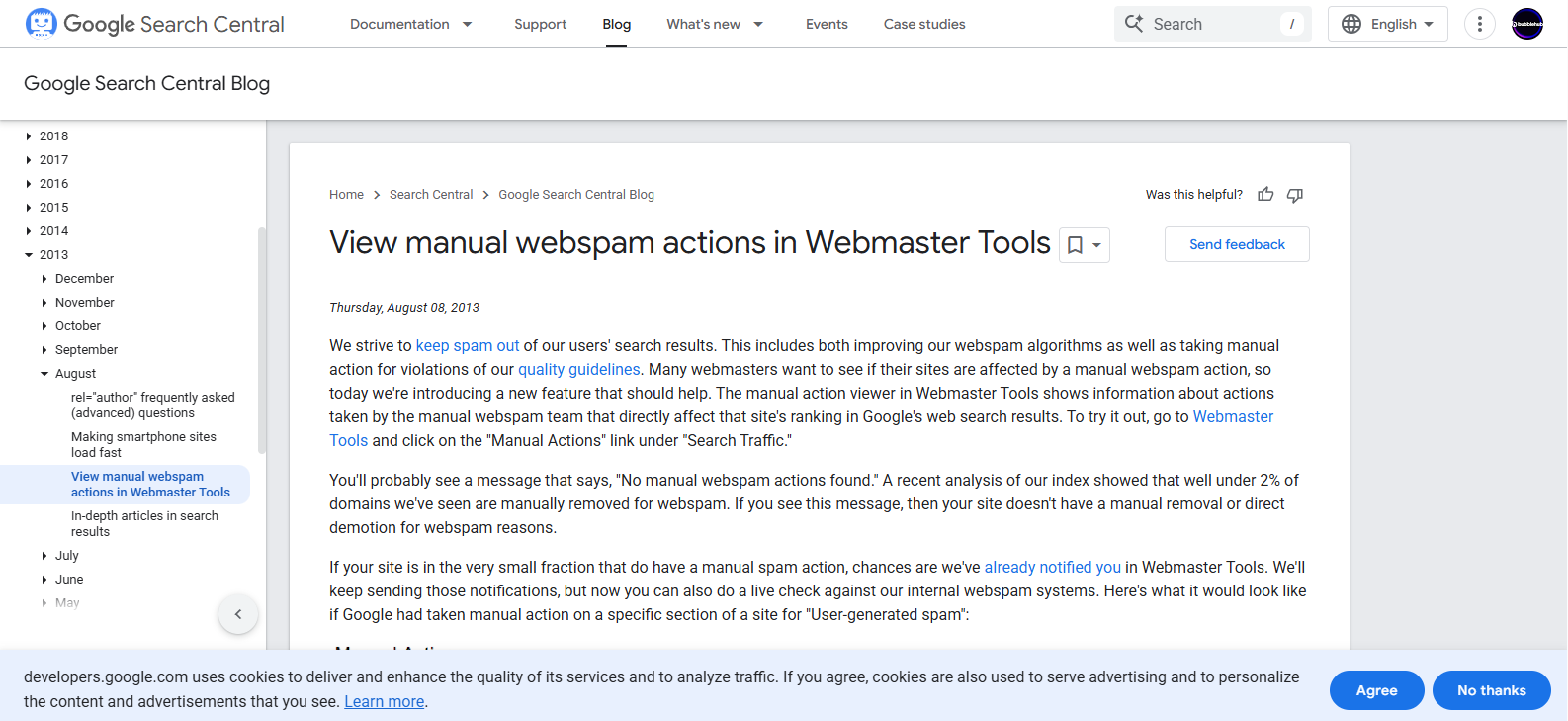Toxic Backlinks | Complete Guide
Imagine this, you have a thriving online business, its your only source of income and one day you wake up and your traffic is decimated. One of the main causes of traffic depreciation is toxic or spammy backlinks, in this guide we will look what toxic links are and how to monior and remove them.
Here's a shocking reality: up to 25% of backlinks pointing to a typical website may be considered low quality or toxic. That's one in four links potentially sabotaging your rankings right now.
Toxic backlinks could be the silent assassin destroying your SEO. These spammy, low-quality links don't just hurt your rankings. They can completely obliterate years of hard work. Sites penalised for toxic backlinks can lose up to 80% or more of their organic traffic overnight. One minute you're ranking on page one, the next you've vanished from Google entirely.
But here's the thing: you can fight back.
This guide reveals exactly how to identify toxic backlinks before they kill your rankings. You'll discover the warning signs that spell disaster, learn which tools actually work, and master the disavow process that saves websites from penalty purgatory. Whether competitors are attacking your site or you've inherited a link disaster, these strategies will protect your SEO investment.
Table of Contents
- What Are Toxic Backlinks and Why Do They Matter for SEO?
- How Do Toxic Backlinks Impact Your Website's Ranking Performance?
- How to Identify Toxic Backlinks in Your Backlink Profile
- Where Do Toxic Backlinks Come From and How to Spot Them?
- What Makes a Backlink Toxic or Spammy in Google's Eyes?
- How to Find Bad Backlinks Using SEMrush and Other SEO Tools
- What Is the Disavow Tool and When Should You Use It?
- How to Protect Your Site from Negative SEO and Unnatural Links
- What Happens When Google Issues a Manual Action for Spammy Links?
- How to Build a Healthy Backlink Profile and Avoid Future Toxic Backlinks
What Are Toxic Backlinks and Why Do They Matter for SEO?

Think of toxic backlinks as poison for your website. They're incoming links from spam sites, link farms, and other dodgy corners of the internet that Google absolutely hates.
These harmful backlinks violate Google's Webmaster Guidelines in every possible way. They trigger algorithmic penalties that crush your rankings faster than you can say "search engine optimisation." Unlike quality backlinks that boost your domain authority and send valuable SEO signals, toxic backlinks actually damage your site's credibility.
Here's what makes this particularly nasty: Google's algorithms have become incredibly sophisticated at spotting manipulative link patterns. They analyse everything. The linking domain's authority. Relevance between sites. Anchor text distribution. Even the context where links appear.
When toxic backlinks pile up in your backlink profile, they create red flags that scream "manipulation" to search engines. The positive signals from your legitimate links get drowned out by the spam. Your site gets flagged as untrustworthy.
The result? Your organic traffic vanishes.
Even a small percentage of toxic links can trigger penalties that devastate your visibility. This makes regular backlink auditing absolutely essential. You can't afford to ignore this threat. Your business depends on staying clean.
How Do Toxic Backlinks Impact Your Website's Ranking Performance?

When search engines detect spammy backlinks pointing to your site, they don't mess about. They slash your domain authority. Tank your page rankings. In severe cases, they remove your site from search results completely. This isn't gradual decline. It's a cliff drop that can destroy businesses.
Google's spam detection algorithms work around the clock, scanning for unnatural links and link spam across millions of websites. When they identify suspicious patterns, automatic penalties kick in immediately. These penalties don't discriminate based on your intentions or business size.
The severity depends on several factors. How many toxic links you have compared to good ones. Your site's overall authority and trust signals. The types of spammy sites linking to you. But even sites with strong foundations can suffer catastrophic ranking losses when toxic backlinks reach critical mass.
Beyond direct penalties, toxic backlinks damage your reputation in Google's eyes. The search engine doesn't just evaluate individual links—it looks at your entire link neighbourhood. When your site associates with known spam networks, private blog networks (PBNs), and link farms, it becomes guilty by association.
This reputation damage makes it harder to recover even after cleaning up. It affects your ability to earn high-quality backlinks from legitimate sources. Other site owners become reluctant to link to domains with questionable link histories.
The financial impact can be devastating. One toxic backlink campaign can wipe out months or years of SEO investment. Revenue disappears. Marketing budgets get wasted. Some businesses never recover.
That's why you need a comprehensive SEO audit to catch these threats early.
How to Identify Toxic Backlinks in Your Backlink Profile

Finding toxic backlinks requires detective work. You need the right tools and know exactly what warning signs to look for.
Start with Google Search Console—it's free and shows exactly which links Google has discovered pointing to your site. Check for manual action warnings or unnatural links notifications. These are red alerts that demand immediate attention.
But Google Search Console only shows a fraction of your backlinks. You need more firepower.
SEMrush's backlink audit tool uses over 45 toxicity markers to identify potentially harmful links. It assigns risk scores based on domain authority, spam signals, anchor text patterns, and known blacklisted sites. The tool flags links that could trigger penalties, giving you a roadmap for cleanup.
However, automated detection isn't perfect. You must manually review suspicious links.
Look for these warning signs: Links from completely unrelated domains. Excessive exact-match anchor text that screams manipulation. Links from obvious link farms or article directories. Sites with minimal content that exist purely for SEO.
Pay special attention to sudden spikes in backlink acquisition. Natural link building happens gradually over time. If you see hundreds of new links appearing overnight, you're probably under attack.
Check the linking domains themselves. Do they look legitimate? Do they serve real users? Or are they obviously artificial sites created to manipulate search engines? Trust your instincts—if something feels off, it probably is.
Most importantly, document everything. Keep detailed records of suspicious links, your analysis, and cleanup efforts. This documentation becomes crucial if you need to file a reconsideration request or communicate with Google about attacks on your site.
Where Do Toxic Backlinks Come From and How to Spot Them?

Toxic backlinks have several common sources, and recognising them can save your rankings.
Negative SEO attacks top the list. Competitors deliberately build thousands of spammy links to sabotage your rankings. They hire cheap link building services that blast your site with links from known spam networks. These attacks often happen after you outrank established competitors or enter lucrative markets.
Automated spam campaigns represent another major source. Bots scrape contact information and blast millions of sites with irrelevant links. Your site gets caught in the crossfire, accumulating links from completely unrelated industries and foreign language sites.
Link farms and private blog networks create massive volumes of toxic backlinks. These networks exist solely to manipulate search engines. They offer no value to real users. The sites typically have thin content, excessive outbound links, and obvious commercial purposes.
Hacked websites become unwitting accomplices in link spam. Criminals inject malicious links into compromised sites, often targeting high-authority domains to pass maximum link juice to their targets.
Here's how to spot these toxic sources:
Random domain names that make no sense. Sites with minimal content or obvious auto-generated text. Excessive outbound links on every page. Foreign language content completely unrelated to your niche. Obvious over-optimisation with commercial anchor text.
The sites feel artificial. They don't serve real users or provide genuine value. Everything about them screams "SEO manipulation."
Trust your gut. If a linking site looks suspicious, it probably is. Better to be overly cautious than to let toxic links destroy your rankings.
What Makes a Backlink Toxic or Spammy in Google's Eyes?

Google evaluates backlinks using hundreds of quality signals. Understanding these factors helps you distinguish between beneficial and harmful links.
Relevance matters most. Links should come from sites related to your industry or topic. A link from a cooking blog to a law firm website raises immediate red flags. Google expects logical connections between linking and target sites.
Anchor text distribution reveals manipulation attempts. Natural links use varied anchor text—branded terms, generic phrases, natural language. Spammy link building focuses heavily on commercial keywords, creating unnatural patterns that trigger penalties.
The linking domain's quality affects toxicity assessment. Links from sites with poor user experience, thin content, or excessive advertising get flagged as low-quality. Sites that exist purely for SEO purposes rather than serving users are inherently toxic.
Link context provides additional clues. Natural links appear within relevant content that adds value for readers. Spammy links get stuffed into footers, sidebars, or completely irrelevant content sections.
Google also examines linking patterns across time. Natural link building happens gradually as sites earn recognition and build relationships. Sudden bursts of links, especially from similar sources, indicate manipulation.
The search engine considers your overall link neighbourhood too. Sites that consistently receive links from known spam networks get flagged for closer scrutiny. Your link profile's composition affects how Google evaluates new incoming links.
Technical factors matter as well. Links from sites with poor loading speeds, security issues, or mobile usability problems carry less weight. Google wants to promote sites that provide excellent user experiences.
Most importantly, Google looks for editorial intent. Did someone choose to link to your site because they genuinely found your content valuable? Or was the link placed for purely SEO purposes? This distinction separates natural links from manipulative ones.
How to Find Bad Backlinks Using SEMrush and Other SEO Tools
SEMrush provides the most comprehensive platform for hunting down bad backlinks. Here's exactly how to use it effectively.
Connect your domain and launch a complete backlink audit. The system crawls your entire link profile and applies sophisticated algorithms using dozens of toxicity markers to identify risk factors. It examines domain authority metrics, spam scores, anchor text distribution, and historical patterns that indicate manipulation. Some cases have found sites with hundreds of toxic links and traffic dropping by more than half in six months.
The audit generates a detailed toxicity report showing your overall risk score and individual link ratings. Focus on links marked with high toxicity scores. These pose the greatest threat to your SEO performance.
But don't rely solely on automated scoring. Many legitimate links get flagged incorrectly, whilst some genuinely toxic links slip through. You need human judgment to make final decisions.
Use Moz's spam score thresholds as an additional guide:
- 0-30%: Low risk - Generally safe links that don't require immediate action
- 31-60%: Moderate risk - In-depth analysis needed to determine toxicity
- Above 60%: High risk - Urgent action needed to avoid penalty
Use SEMrush's filtering options to identify patterns. Sort by anchor text to find over-optimisation. Filter by domain authority to spot links from weak sites. Look at referring domains to identify potential link networks.
Cross-reference SEMrush data with other tools for complete coverage. Ahrefs offers different perspectives on link quality assessment. Majestic provides trust and citation flow metrics that reveal link neighbourhood quality.
Google Search Console remains your most authoritative source. It shows exactly which links Google has discovered and indexed. If Google hasn't found a link, it can't hurt your rankings.
Moz's Link Explorer provides spam score metrics based on machine learning algorithms. It identifies features common to penalised sites and flags links from domains exhibiting similar characteristics.
Combine data from multiple sources to build a complete picture. No single tool catches everything. Some links that appear toxic in one tool might be perfectly safe according to another. Others consistently get flagged across all platforms. These demand immediate attention.
Document your findings systematically. Create spreadsheets tracking toxic links, their sources, risk levels, and cleanup actions. This documentation proves invaluable during the disavow process and potential reconsideration requests.
What Is the Disavow Tool and When Should You Use It?

Google's disavow tool serves as your last resort weapon against toxic backlinks. It allows you to mitigate damage by telling Google to ignore harmful links in ranking calculations. The tool formally requests that the search engine ignore specific backlinks when calculating your rankings and algorithmic assessments.
The tool accepts a specially formatted disavow file containing URLs or entire domains you want Google to ignore. Upload this file through Google Search Console, and Google will process your request during the next crawl cycle.
But here's the critical point: use the disavow tool carefully. Incorrect implementation can damage your SEO performance by removing valuable link equity from legitimate sources.
Google recommends exhausting removal efforts before disavowing. Contact site owners requesting link removal. Document your outreach attempts. Only disavow links you cannot remove through direct contact.
However, certain situations justify immediate disavowing:
Large-scale negative SEO attacks with thousands of obvious spam links. Links from known penalty-inducing networks. Domains that consistently ignore removal requests. Sites involved in link schemes or private blog networks.
When preparing your disavow file, focus on clearly toxic backlinks rather than marginally questionable ones. Over-disavowing removes valuable link equity and can hurt your rankings. Be conservative and strategic.
Include only the most harmful links that pose genuine threats. Obvious spam domains. Sites that received manual penalties. Links from networks designed purely for manipulation.
Format your disavow file correctly:
# Remove toxic links from spamnetwork.com
domain:spamnetwork.com
# Remove specific spam pages
http://example-spam-site.com/bad-page
http://another-spam.com/link-farm
Document everything. Maintain records of which links you've tried to remove manually. Include outreach emails and responses. This documentation supports potential reconsideration requests.
Remember: disavowing takes time to show results. Google processes disavow files during regular crawl cycles, which can take weeks or months depending on your site's crawl frequency.
How to Protect Your Site from Negative SEO and Unnatural Links
Prevention beats cure when dealing with toxic backlinks. Smart monitoring and defence strategies help you detect attacks before they devastate your rankings.
Set up automated monitoring using Google Search Console alerts and third-party SEO tools. Configure notifications for unusual backlink spikes—natural link building happens gradually, whilst attacks create sudden surges that are easy to spot.
Build a strong foundational backlink profile that can absorb some toxic link impact without triggering penalties. Sites with diverse, high-quality link portfolios are more resilient against negative SEO attempts.
Focus on earning legitimate backlinks through proven SEO strategies. Create valuable content that naturally attracts links. Build genuine relationships within your industry. Engage in authentic outreach campaigns that provide real value to target sites.
Monitor your brand mentions across the web. Criminals often target businesses that are growing rapidly or threatening established competitors. Stay alert for unusual activity around your brand keywords.
When attacks occur, respond immediately. Quick action minimises damage and shows Google you're actively fighting spam. Document everything. Screenshot spam links, save emails, record cleanup efforts.
Create removal request templates for efficient outreach. Many spam sites ignore individual requests but respond to professional, persistent communication. Follow up multiple times before giving up.
Implement additional security measures:
Monitor your website for unauthorised changes or hacked content. Set up Google Search Console alerts for crawl errors and security issues. Use strong passwords and two-factor authentication on all accounts.
Build relationships with other businesses in your industry. Collaborative monitoring helps identify negative SEO campaigns targeting multiple sites. Share information about suspicious activity and coordinate responses.
Consider working with an experienced technical SEO specialist who can implement advanced monitoring and protection strategies. Professional help often pays for itself by preventing costly penalties.
What Happens When Google Issues a Manual Action for Spammy Links?

A manual action for spammy links represents Google's nuclear option. Human reviewers have examined your site and found unnatural link patterns that violate their guidelines.
Unlike algorithmic penalties that apply automatically, manual actions require human intervention. Manual penalties by Google employees lead to immediate, dramatic drops in traffic and require a thorough cleanup and reconsideration request for recovery. You'll receive clear notifications through Google Search Console explaining exactly what Google found problematic.
The impact is immediate and devastating. Your rankings plummet across target keywords. Organic traffic disappears. Revenue can drop by 80% or more overnight.
Manual actions vary in scope:
Site-wide penalties affect your entire domain. Partial penalties target specific sections or pages. The notification explains which parts of your site are impacted and provides examples of problematic links.
Recovery requires comprehensive cleanup and a detailed reconsideration request. You must address every issue Google identified, remove or disavow all toxic backlinks, and demonstrate genuine commitment to following their guidelines.
The reconsideration process involves several steps:
Clean up your backlink profile thoroughly. Remove toxic links through direct outreach. Disavow links you cannot remove manually. Document all cleanup efforts with screenshots and saved emails.
Write a detailed reconsideration request explaining what happened, what you've done to fix it, and how you'll prevent future problems. Be honest, specific, and thorough. Google's reviewers can spot generic templates and insincere requests.
Wait for Google's response. Processing times vary from weeks to months depending on the complexity of your case and volume of requests. Some sites receive approval quickly, others require multiple resubmissions.
Success depends on thoroughness and sincerity. Half-hearted cleanup efforts get rejected immediately. You must demonstrate genuine commitment to playing by Google's rules.
The good news? Sites can fully recover from manual actions with proper cleanup. Rankings often return to previous levels or even improve after successful reconsideration. But the process requires patience, persistence, and professional expertise.
How to Build a Healthy Backlink Profile and Avoid Future Toxic Backlinks
Building a healthy backlink profile protects you from future toxic link disasters whilst boosting your SEO performance.
Focus on quality over quantity. A few high-authority, relevant backlinks provide more value than hundreds of low-quality spam links. Search engines reward sites that earn editorial links from trusted sources.
Create content that naturally attracts backlinks. Original research, comprehensive guides, industry surveys, and thought leadership pieces generate organic link interest. When your content provides genuine value, other sites want to reference and share it.
Diversify your link sources. Avoid over-reliance on any single type of link or linking domain. Natural backlink profiles include links from various sources: industry publications, news sites, blogs, directories, and social platforms.
Maintain natural anchor text distribution. Use varied anchor text including branded terms, generic phrases, and natural language. Avoid over-optimising with commercial keywords that create manipulation signals.
Build genuine relationships within your industry. Attend conferences, participate in online communities, collaborate on projects, and provide value to other businesses. Real relationships generate authentic link opportunities.
Monitor your link acquisition patterns. Gradual, steady growth looks natural. Sudden spikes raise red flags. If you notice unusual activity, investigate immediately to identify potential attacks or technical issues.
Regular maintenance prevents small problems from becoming major disasters. Conduct monthly backlink audits to identify new toxic links before they accumulate. Address issues promptly whilst they're still manageable.
Work with reputable SEO professionals who understand white-hat link building techniques. Avoid agencies that promise unrealistic results or use questionable tactics. The short-term gains aren't worth the long-term risks.
Consider partnering with an established SEO agency that can guide your link building efforts whilst protecting you from toxic link threats. Professional expertise often prevents costly mistakes that damage your rankings.
Document your link building efforts. Maintain records of outreach campaigns, content promotion activities, and relationship building initiatives. This documentation proves your commitment to ethical SEO practices.
Key Takeaways: Protecting Your SEO from Toxic Backlinks
Monitor relentlessly: Check your backlink profile monthly using Google Search Console and SEMrush. Early detection prevents major damage.
Quality beats quantity: Focus on earning fewer high-quality backlinks rather than accumulating large volumes of questionable links.
Use disavow strategically: Only disavow clearly toxic backlinks after attempting removal. Over-disavowing hurts more than it helps.
Document everything: Keep detailed records of toxic links, removal efforts, and cleanup activities. This documentation supports reconsideration requests.
Respond quickly: Set up alerts for unusual backlink activity. Immediate response minimises damage from negative SEO attacks.
Build naturally: Develop diverse anchor text patterns and gradual link acquisition timelines that mirror natural growth.
Understand Google's rules: Stay informed about quality guidelines and avoid practices that could attract penalties.
Invest in prevention: Strong foundational backlink profiles provide the best protection against toxic link impact.
Your website's future depends on clean, high-quality backlinks. Don't let toxic links destroy years of hard work. Take action now to protect your SEO investment.
Need help cleaning up toxic backlinks or building a stronger link profile? Our SEO experts have helped hundreds of businesses recover from link penalties and build sustainable rankings. Contact us today for a free consultation and discover how we can protect your website from toxic link threats.







